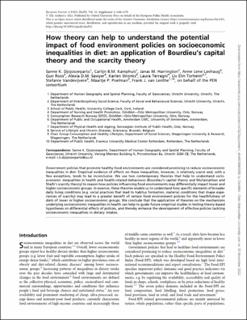| dc.contributor.author | Djojosoeparto, Sanne K. | |
| dc.contributor.author | Kamphuis, Carlijn B.M. | |
| dc.contributor.author | Harrington, Janas M. | |
| dc.contributor.author | Løvhaug, Anne Lene | |
| dc.contributor.author | Roos, Gun | |
| dc.contributor.author | Sawyer, Alexia | |
| dc.contributor.author | Stronks, Karien | |
| dc.contributor.author | Terragni, Laura | |
| dc.contributor.author | Torheim, Liv Elin | |
| dc.contributor.author | Vandevijvere, Stefanie | |
| dc.contributor.author | Poelman, Maartje | |
| dc.contributor.author | van Lenthe, Frank J. | |
| dc.date.accessioned | 2022-12-01T09:16:28Z | |
| dc.date.available | 2022-12-01T09:16:28Z | |
| dc.date.created | 2022-11-30T10:12:38Z | |
| dc.date.issued | 2022 | |
| dc.identifier.citation | European Journal of Public Health. 2022, 32 iv66-iv70. | en_US |
| dc.identifier.issn | 1101-1262 | |
| dc.identifier.uri | https://hdl.handle.net/11250/3035227 | |
| dc.description.abstract | Government policies that promote healthy food environments are considered promising to reduce socioeconomic inequalities in diet. Empirical evidence of effects on these inequalities, however, is relatively scarce and, with a few exceptions, tends to be inconclusive. We use two contemporary theories that help to understand socioeconomic inequalities in health and health-related behaviours (Bourdieu’s capital theory and Mullainathan and Shafir’s scarcity theory) to reason how policies influencing food environments may differentially impact lower and higher socioeconomic groups. In essence, these theories enable us to understand how specific elements of broader daily living conditions (e.g. social practices that lead to habitus formation, material conditions that shape experiences of scarcity) may lead to a greater benefit of certain food environment policies for the healthfulness of diets of lower or higher socioeconomic groups. We conclude that the application of theories on the mechanisms underlying socioeconomic inequalities in health can help to guide future empirical studies in testing theory-based hypotheses on differential effects of policies, and thereby enhance the development of effective policies tackling socioeconomic inequalities in dietary intakes | en_US |
| dc.language.iso | eng | en_US |
| dc.rights | Navngivelse 4.0 Internasjonal | * |
| dc.rights.uri | http://creativecommons.org/licenses/by/4.0/deed.no | * |
| dc.title | How theory can help to understand the potential impact of food environment policies on socioeconomic inequalities in diet: An application of Bourdieu’s capital theory and the scarcity theory | en_US |
| dc.type | Peer reviewed | en_US |
| dc.type | Journal article | en_US |
| dc.description.version | publishedVersion | en_US |
| cristin.ispublished | true | |
| cristin.fulltext | original | |
| cristin.qualitycode | 1 | |
| dc.identifier.doi | https://doi.org/10.1093/eurpub/ckac052 | |
| dc.identifier.cristin | 2085149 | |
| dc.source.journal | European Journal of Public Health | en_US |
| dc.source.volume | 32 | en_US |
| dc.source.pagenumber | iv66-iv70 | en_US |

